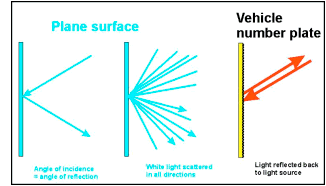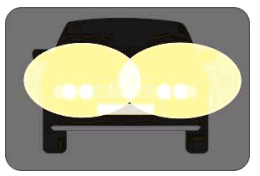Raspberry Pi
ANPR Camera Project by Jamie Johnson

please help and click the ads to fund this project
The Behaviour of Reflected LightTo explain some further technology behind successful ANPR capture we need to look at the behaviour of light. A basic law of light is that the angle of incidence equals the angle of reflection. However, number plates in the UK and most other countries have a special characteristic; they are known as RETRO-REFLECTIVE. The surface is covered in hundreds of tiny hemispheres which cause light to be reflected back to the source. This is the same technology used in safety clothing and signs. No matter from which direction the light is directed, it always reflects back and makes them very visible.
The Application of Infrared Illumination to ANPR If a standard colour or monochrome camera was focused to read number plates it would have to contend with a huge variety of lighting conditions, daytime, night-time, sunlight, backlight, headlights, and so on. One configuration simply would not cope with all conditions, so there is a need to provide a constant level and direction of illumination irrespective of any other conditions.
so we need to make a camera to take capture of number plate data.The camera must be sensitive to the infrared part of the spectrum, to at least 850 nanometres. Then it must be fitted with a filter to restrict the visible part of the spectrum. The lens would have a manual iris set fully open and the shutter speed set to 1/1000th second. Finally an infrared source must be fitted adjacent to the camera.Therefore, taking advantage of the retro-reflective characteristics of number plates, the illumination from the illuminator will be reflected directly back to the camera. Thus only infrared light will be seen without any visible light or other reflections or refractions. The picture will of course be black with no detail except for the number plate.
The OCR software then takes care of converting the image to usable code.Note that this is the sort of image on the monitor both day and night.
MY FIRST PROJECT WITHOUT THE RASPBERRY PI LAST YEAR
About Infra Red & ANPR
The Behaviour of Reflected LightTo explain some further technology behind successful ANPR capture we need to look at the behaviour of light. A basic law of light is that the angle of incidence equals the angle of reflection. However, number plates in the UK and most other countries have a special characteristic; they are known as RETRO-REFLECTIVE. The surface is covered in hundreds of tiny hemispheres which cause light to be reflected back to the source. This is the same technology used in safety clothing and signs. No matter from which direction the light is directed, it always reflects back and makes them very visible.
The Application of Infrared Illumination to ANPR If a standard colour or monochrome camera was focused to read number plates it would have to contend with a huge variety of lighting conditions, daytime, night-time, sunlight, backlight, headlights, and so on. One configuration simply would not cope with all conditions, so there is a need to provide a constant level and direction of illumination irrespective of any other conditions.
so we need to make a camera to take capture of number plate data.The camera must be sensitive to the infrared part of the spectrum, to at least 850 nanometres. Then it must be fitted with a filter to restrict the visible part of the spectrum. The lens would have a manual iris set fully open and the shutter speed set to 1/1000th second. Finally an infrared source must be fitted adjacent to the camera.Therefore, taking advantage of the retro-reflective characteristics of number plates, the illumination from the illuminator will be reflected directly back to the camera. Thus only infrared light will be seen without any visible light or other reflections or refractions. The picture will of course be black with no detail except for the number plate.
The OCR software then takes care of converting the image to usable code.Note that this is the sort of image on the monitor both day and night.

The Prototype


